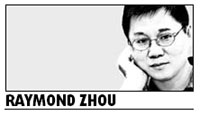Usually one hates to admit he or she is wrong on a prediction. But I, for one, am more than glad to say I did not get it right on the Zhang Yimou-directed extravaganza for last night's Beijing Olympics opening ceremony.
He achieved something I thought he was both incapable of and unwilling to do.

To start with, he went for the high-brow - if we use the CCTV New Year's eve gala as a benchmark - a risky move considering the size of the audience. Of course there was plenty to please the senses, but movable type printing and ancient paintings seemed too archaic a subject. Hey, it turned out to be some of the most ingenious moments of the evening.
The concept of an ink painting was exactly what I said Zhang and his team would never dare choose. The distilled colors of black and white are simply the opposite of his favorite color scheme of bright red and yellow, China's de rigueur choice for celebration. I do not know how much pressure he had to withstand before he could convince people that dancers clad in pitch black imitating brush strokes or in white doing the tai chi would be a good idea.
It seems that Zhang and company were inspired by the 2004 Athens show, which did not aim to win over people with no knowledge of the ancient civilization. While sculpture was the manifestation in Greece, Zhang resorted to Chinese painting, upon whose abstract lines a colorful world emerged, including the not surprising Peking Opera and the very well produced "Ritual Music", where grand and regal styles of the Tang Dynasty literally rose and reached for the sky.
There was not as much hi-tech as I had expected, especially after watching the opening ceremony of the 2006 Doha Asian Games. The mythological figures such as Pangu, Nuwa and Houyi were nowhere in sight. They certainly would have wowed us - or the child in us. Was this a technological factor is an aesthetic one? The fast moving and sudden appearance of large props in a vast arena visible from all four sides no doubt presented a daunting task. On second thought, they would not have fit into the current theme, which seemed to be from ancient glory to future glory.
The show did make use of the vertical space, such as the flying dance girls, the astronauts, the giant globe, and the encircling panel in the ceiling that forms a clever "crown" where images constantly evolved to compliment the action on the floor. However, the best action indeed took place on solid ground, where both old-style shape formations and new surprises coalesced into one.
Now that I have listed my errors, I will run down the list of what I got right or almost right. Sarah Brightman is close to Celine Dion in terms of power ballads, and Liu Huan was on the shortlist I mentioned. It was a safe bet, which deprived us of the shock of seeing a Chinese folk-style warbler or a total unknown.
Harmony was brought up more than once, and emphasized in the Confucius and Taoist numbers. The image of thousands of Confucius look-alikes, the word formed by the human-formed movable type, the cosmic atmosphere of Lang Lang's piano solo, the doves, the sights and sounds of Mother Nature, the 2,008 smiling faces from all over the world - all pointed to the omnipresent force of harmony.
Still, I regret the image of phoenix was passed over. A dancer or a group of dancers in one phoenix costume could have parachuted into the stadium, if rising up is too cumbersome. But hey, this was more innovative and ideology-free than I had expected. I have no reason to complain.
Email: raymondzhou@chinadaily.com.cn